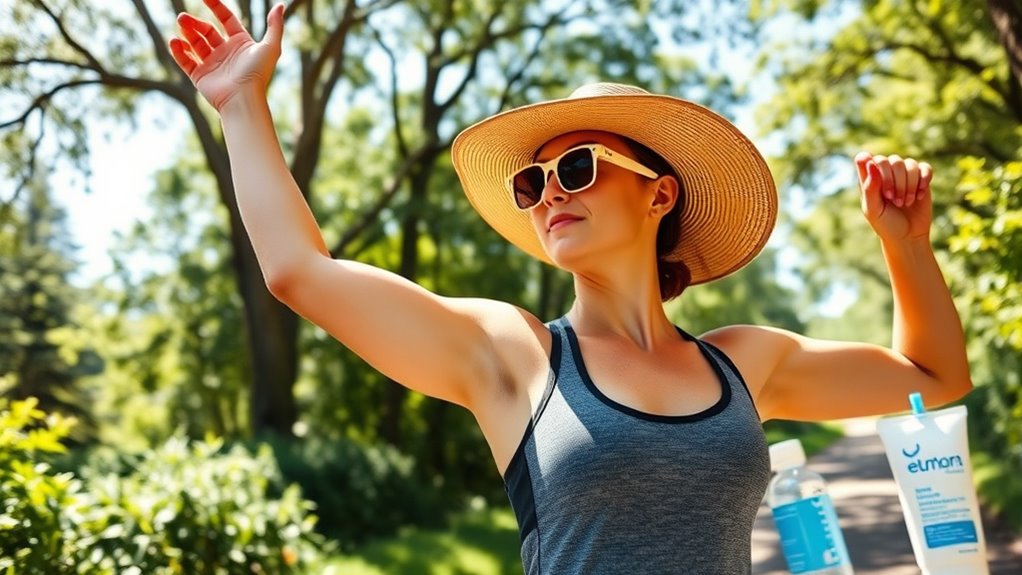To stay safe during long outdoor workouts, choose gear with high UPF ratings, wear wide-brimmed hats, and UV-protective sunglasses to shield your face and eyes. Schedule workouts early morning or late afternoon to avoid peak sun hours, and always apply broad-spectrum sunscreen generously 15 minutes before activity, reapplying every two hours. Stay well-hydrated and monitor your skin for signs of sunburn or dehydration. Keep going to discover more tips for confident sun safety.
Key Takeaways
- Schedule workouts during early morning or late afternoon to avoid peak UV hours.
- Apply broad-spectrum sunscreen generously 15 minutes before exercise and reapply every two hours.
- Wear protective clothing, including UPF-rated fabrics, wide-brimmed hats, and UV-protective sunglasses.
- Stay hydrated with water or electrolyte drinks and monitor skin for signs of sunburn or dehydration.
- Be mindful of environmental factors like pollution and reflectivity surfaces to enhance sun safety during extended outdoor activities.
Choosing the Right Sun Protection Gear
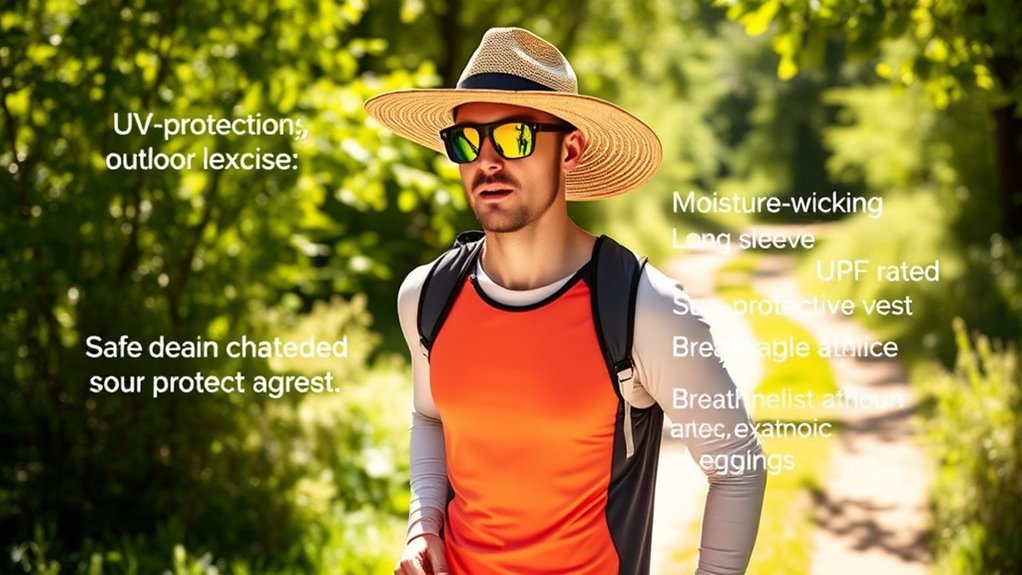
Choosing the right sun protection gear is essential for effective sun safety. The UV index tells you how strong the sun’s rays are, helping you decide what protection to wear. When the UV index is high, you’ll need more coverage, like broad-spectrum sunscreen, UPF clothing, or a wide-brimmed hat. Many sun safety myths can lead you astray, such as believing you don’t need protection on cloudy days or that sunscreen is only for the beach. In reality, UV rays penetrate clouds and reflect off surfaces, so you’re still at risk. By understanding the UV index and dispelling these myths, you can make smarter choices about your gear, ensuring you stay protected during your long workout days outdoors. Additionally, advancements in automation technologies are improving the development and availability of innovative sun protection products. Recognizing the importance of personality traits such as resilience and adaptability can also help you maintain consistent sun safety habits even in challenging conditions.
Timing Your Workout to Minimize Sun Exposure
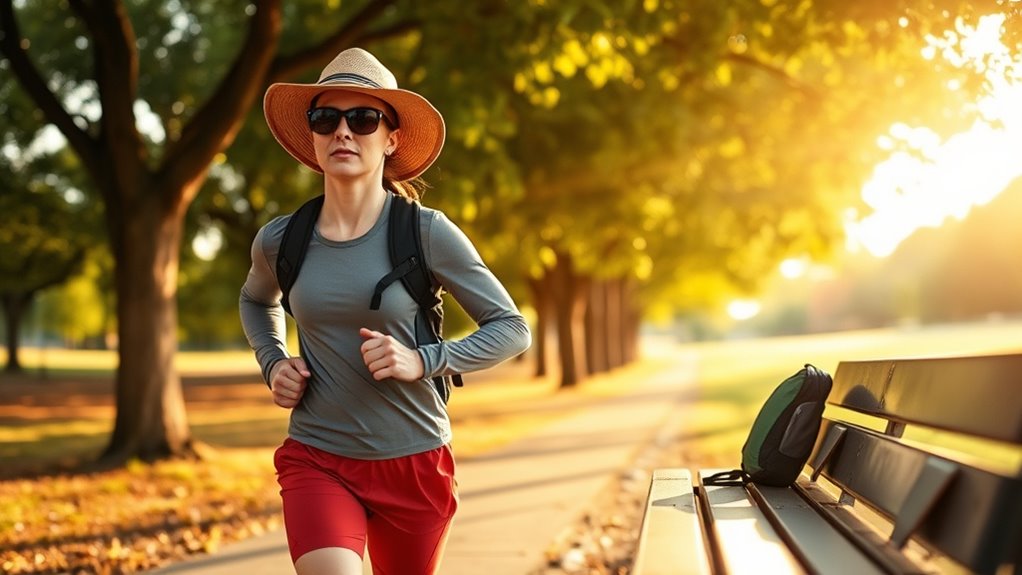
To reduce your risk of sun damage, plan your outdoor workouts during times when the sun’s rays are less intense. Sun exposure timing is vital; scheduling workouts early morning or late afternoon helps you avoid peak UV hours. Being aware of UV Intensity levels can further guide your decision-making for safe exercise times. Use this table to guide your workout scheduling:
| Time of Day | UV Intensity |
|---|---|
| Early morning | Low |
| Midday | High |
| Late afternoon | Moderate |
| Evening | Minimal |
Choosing the right sun exposure times minimizes the potential for skin damage and long-term health risks. Additionally, understanding solar position can help you better anticipate UV levels throughout the day. Recognizing the impact of solar elevation on UV exposure allows you to plan more effectively. Adjust your workout timing based on the sun’s position, and you’ll enjoy outdoor activity with less worry about harmful UV rays.
Applying Sunscreen Effectively and Consistently

Applying sunscreen correctly and consistently is essential for effective sun protection. To maximize its benefits, use proper reapplication techniques—apply generously 15 minutes before sun exposure, and reapply every two hours, or immediately after sweating or swimming. Be sure to cover all exposed skin, including often-missed areas like ears, neck, and the tops of your feet. Understanding sunscreen ingredient benefits helps you choose the right product: mineral sunscreens with zinc oxide or titanium dioxide provide broad-spectrum protection and are gentle on sensitive skin, while chemical options like avobenzone or oxybenzone absorb UV rays effectively. Regular reapplication ensures continuous UV protection, reducing your risk of sunburn and long-term skin damage. Selecting the appropriate sunscreen involves considering your skin type, activity level, and the specific formulation that suits your needs. Proper sunscreen application can significantly improve your sun safety routine and protect your skin health.
Dressing Appropriately for Sun Safety
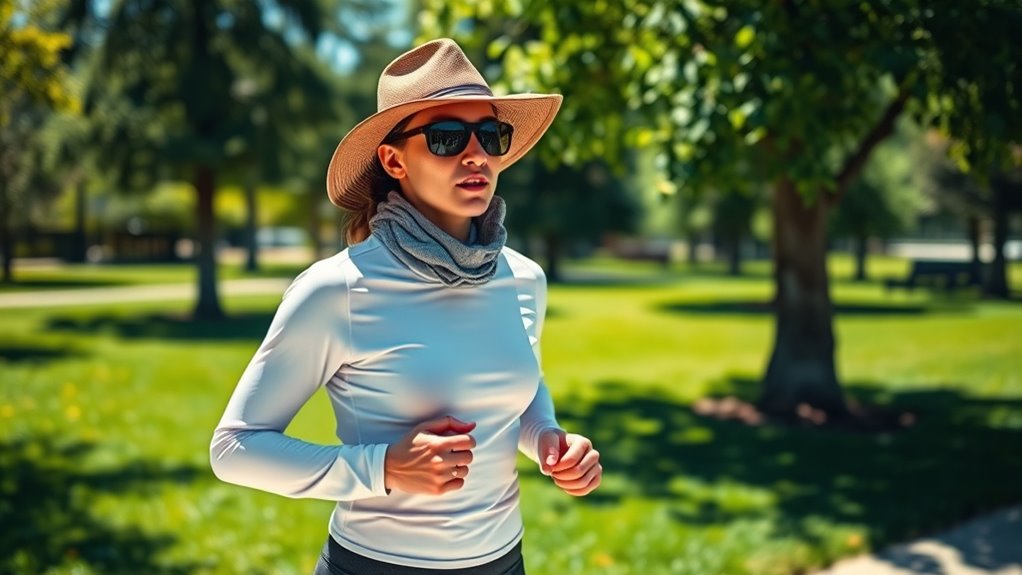
Since your clothing acts as a primary barrier against harmful UV rays, dressing appropriately is essential for sun safety. Choose lightweight, tightly woven fabrics that cover as much skin as possible, like long-sleeved shirts and full-length pants. Pay attention to UV index awareness—on days with higher UV levels, opt for darker colors and thicker materials, which offer better protection. Avoid sun safety myths, such as believing that dark clothing always blocks more UV rays; fabric weave and material matter more. Wide-brim hats and UV-protective sunglasses also help shield your face and eyes from the sun. Incorporating natural materials like linen and cotton can also enhance breathability and comfort while providing effective coverage. Additionally, selecting clothing with a high UPF rating can significantly improve your sun protection. For long workout days, consider clothing with specialized UV protection features that can enhance your defense against UV rays. Using appropriate clothing can also help reduce the need for frequent reapplication of sunscreen and ensure continuous protection during extended outdoor activities. Remember, proper clothing complements sunscreen and enhances your overall sun safety during long workout days.
Staying Hydrated and Monitoring Your Skin’s Response
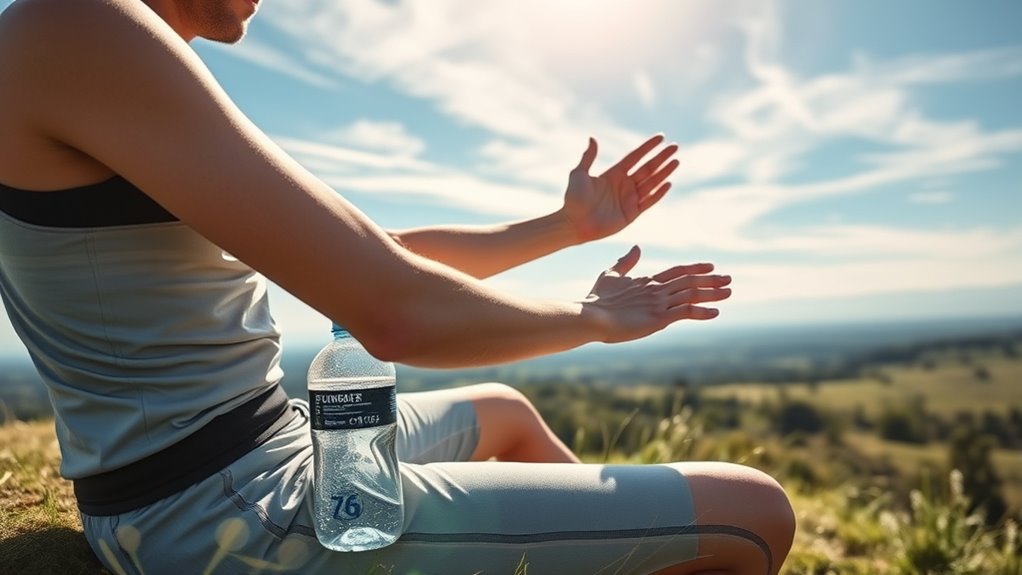
Staying hydrated is essential for maintaining your skin’s health and preventing heat-related issues during sun exposure. To do this, adopt effective hydration strategies like drinking water regularly, incorporating electrolyte drinks, and avoiding caffeine or alcohol. As you exercise, pay close attention to your skin’s response; skin reaction tracking helps identify early signs of sunburn, dehydration, or heat exhaustion. If your skin becomes red, tender, or develops a rash, it’s a sign to cool down and hydrate more. Keep a water bottle nearby and take frequent sips, especially if you notice any discomfort. Monitoring your skin’s response ensures you’re staying safe while enjoying long workout days in the sun. Proper hydration and awareness are key to preventing sun-related health issues. Additionally, understanding how environmental factors like air pollution can impact your skin’s health can help you take extra precautions during outdoor activities. Recognizing the importance of benefits of wood-burning can also inspire you to create a cozy, sustainable environment when relaxing indoors after your workout. Staying informed about pinball machine weights can remind you of the importance of safety when handling equipment during outdoor activities. Incorporating sun protection measures such as wearing hats and sunscreen further enhances your safety during extended outdoor exercise sessions.
Frequently Asked Questions
How Often Should I Reapply Sunscreen During Extended Outdoor Workouts?
During extended outdoor workouts, you should reapply sunscreen regularly to maintain protection. Typically, you need to reapply every two hours, especially if you’re sweating or swimming. This guarantees your skin stays protected and reduces the risk of sunburn or UV damage. Remember, consistent sunscreen reapplication is a key part of workout sun safety, so keep a travel-sized bottle handy and make reapplying a routine part of your outdoor exercise.
Can Certain Fabrics Increase or Decrease Sun Protection During Exercise?
Think of your clothing as a shield in a battle against the sun. Fabric types like tightly woven, UPF-rated materials act like armor, providing better protection. Moisture-wicking fabrics help keep you dry, reducing sun exposure on your skin. Conversely, lightweight, loose fabrics might let more rays through, diminishing protection. Choose athletic wear made from specialized, sun-resistant fabrics to armor yourself effectively during your workout, ensuring you stay safe and comfortable.
Are There Specific Sun Safety Considerations for Different Skin Tones?
You should consider your skin tone when thinking about sun protection. People with lighter skin often need higher SPF and more frequent reapplication, while those with darker skin may have some natural protection but still risk sun damage. Regardless of skin tone, wear broad-spectrum sunscreen, seek shade during peak hours, and wear protective clothing. These steps help you effectively guard against UV rays tailored to your skin’s specific needs.
What Are Signs of Sunstroke or Heat Exhaustion to Watch For?
Ever felt dizzy or nauseous after hours in the sun? Those are signs of sunstroke or heat exhaustion. You should watch for symptoms like heavy sweating, weakness, rapid heartbeat, and confusion. To prevent this, follow hydration tips, such as drinking water regularly, and choose light, breathable clothing. Do you notice any of these signs? If so, get to a cool place, hydrate, and seek medical help immediately.
How Can I Protect My Eyes From UV Rays During Outdoor Workouts?
To protect your eyes from UV rays during outdoor workouts, prioritize UV protection by wearing sunglasses with 100% UVA and UVB filters. Opt for wraparound styles to block rays from all angles and choose lenses that reduce glare. Eye safety is essential, so avoid looking directly at the sun and take breaks in shaded areas. These steps help prevent eye damage and keep your vision clear during long outdoor sessions.
Conclusion
By following these sun safety tips, you’ll outsmart the sun and keep your skin protected no matter how long your workout lasts. Remember, your skin’s health is your greatest asset—more valuable than gold, in fact! So, gear up with the right protection, stay hydrated, and keep an eye on your skin’s response. With these habits, you’ll conquer those sunny workout days without a single sunburn or skin mishap!

